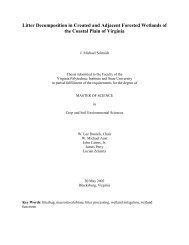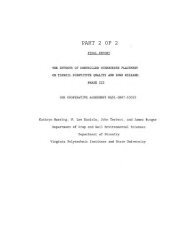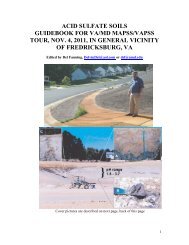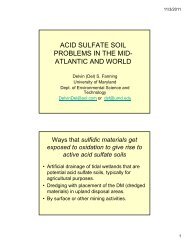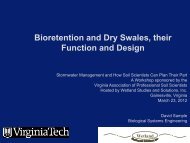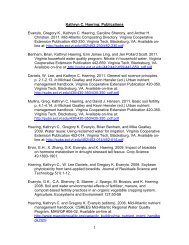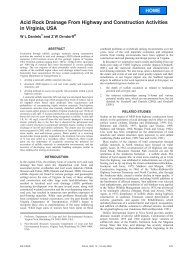Remediation of PAH-Contaminated Soils and Sediments: A ...
Remediation of PAH-Contaminated Soils and Sediments: A ...
Remediation of PAH-Contaminated Soils and Sediments: A ...
Create successful ePaper yourself
Turn your PDF publications into a flip-book with our unique Google optimized e-Paper software.
1. Fenton’s reagent – formation <strong>of</strong> hydroxyl radical (to be discussed in more<br />
detail in Chemical Techniques for Enhancing <strong>PAH</strong> Degradation)<br />
H2O2 + Fe 2+ → • OH + OH − + Fe 3+<br />
2. Ozone – formation <strong>of</strong> hydroxyl radical or direct oxidation by ozone radical<br />
(to be discussed in more detail in Chemical Techniques for Enhancing<br />
<strong>PAH</strong> Degradation)<br />
O3 → HO2 - → • OH<br />
O3 +O2 •- → O •3-<br />
3. Sodium persulfate – formation <strong>of</strong> persulfate anions (st<strong>and</strong>ard oxidation<br />
potential <strong>of</strong> 2.0V); additions <strong>of</strong> metals can subsequently create sulfate<br />
radicals (st<strong>and</strong>ard oxidation potential <strong>of</strong> 2.6V)<br />
Na2S2O8 → S2O8 − + 2Na +<br />
S2O8 − + Fe 2+ → 2SO4 •- + Fe 3+<br />
The mechanism by which free radicals attack <strong>PAH</strong>s is similar for all free radicals<br />
<strong>and</strong> works by the following examples <strong>of</strong> hydroxyl radical oxidation with reaction 1<br />
usually initiating ring cleavage (Ferrarese et al., 2008; Flotron et al., 2005):<br />
1) R + • OH → • ROH (hydroxyl addition)<br />
2) ROH + • OH → • R + H2O (hydrogen abstraction)<br />
In recent investigations the use <strong>of</strong> potassium permanganate (KMnO4) has also<br />
shown some success. The reaction proceeds without the formation <strong>of</strong> a radical<br />
species. The reaction occurs due to the high oxidation state (+7) <strong>of</strong> the<br />
manganese atom in the permanganate salt.<br />
MnO4 − +4H + +3e − → MnO2(s) +2H2O<br />
Although permanganate is a strong oxidant, with a st<strong>and</strong>ard oxidation potential <strong>of</strong><br />
1.7V, it lacks the ability to attack the benzene ring. The inability to attack the<br />
benzene ring has limited the use <strong>of</strong> potassium permanganate in <strong>PAH</strong><br />
degradation (Ferrarese et al., 2008).<br />
In complex soil mixtures, the use <strong>of</strong> advanced oxidation processes can become<br />
complicated by soil organic matter, which has the ability to scavenge nonselective<br />
oxidants as well as sequester <strong>PAH</strong>s into hydrophobic pores. To<br />
overcome <strong>PAH</strong> solubility issues, previous investigations have increased oxidant<br />
concentrations. Care must be taken when using this approach; however, as over<br />
application <strong>of</strong> the oxidant can cause self consumption <strong>of</strong> the radical species<br />
(Ferrarese et al., 2008). Other investigations have sought to overcome low <strong>PAH</strong><br />
35



